Is Frank W Benson Art Work Frfamedthe Hilltop Worth Anuythiong
| Frank Weston Benson | |
|---|---|
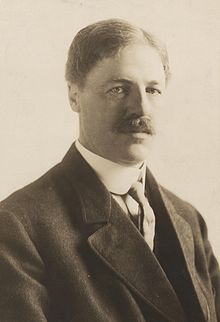 circa 1895 | |
| Born | (1862-03-24)March 24, 1862 Salem, Massachusetts |
| Died | November 15, 1951(1951-11-15) (aged 89) Salem, Massachusetts |
| Nationality | American |
| Education | Schoolhouse of the Museum of Fine Arts, Boston, Académie Julian Paris. |
| Known for | Impressionist painting |

Frank Weston Benson, oft referred to equally Frank W. Benson, (March 24, 1862 – Nov 15, 1951) was an American creative person from Salem, Massachusetts known for his Realistic portraits, American Impressionist paintings, watercolors and etchings. He began his career painting portraits of distinguished families and murals for the Library of Congress. Some of his best known paintings (Eleanor, Museum of Fine Arts, Boston; Summer, Rhode Isle School of Blueprint Museum) describe his daughters outdoors at Benson'south summer home, Wooster Farm, on the island of North Haven, Maine. He as well produced numerous oil, wash and watercolor paintings and etchings of wildfowl and landscapes.
In 1880, Benson began to study at the Schoolhouse of the Museum of Fine Arts, Boston under both Otto Grundmann and Frederic Crowninshield.[1] In 1883 he travelled to Paris to study at the Académie Julian.[2] He enjoyed a distinguished career as an instructor and department caput at the Schoolhouse of the Museum of Fine Arts, Boston. He was a founding member of the 10 American Painters, American Academy of Arts and Letters and The Guild of Boston Artists.
Biography [edit]
Early years [edit]
Frank Weston Benson was built-in to George Wiggin Benson, a successful cotton broker, and Elisabeth Poole,[iii] [4] [five] : 13 from families who founded Salem, Massachusetts. Benson obtained his appreciation of the sea from his gramps, Helm Samuel Benson. When he was 12, he was given a sailboat[5] : 13 in which he explored the waterways and marshes and raced against his blood brother, John Prentiss Benson. To encourage educational activity, Benson's parents gave their children a weekly allowance to foster contained study and hobbies, such as Salem'southward Hamilton Hall trip the light fantastic toe classes, Lyceum lectures[6] or equipment for photography. The brothers kept agile by participating in sports, equally well equally line-fishing and hunting.[5] : 16–17
Benson's father gave him a shotgun and taught him how to hunt shore birds along the North Shore and wildfowl in the local fields and marshes.[5] : 13 He spent nigh all of his weekends hunting or fishing in the fields, marshes and streams.[5] : 16–17 To his good friend Dan Henderson, he wrote of their childhood adventures:
"We used to spend our Saturdays chasing coot and old squaws in Salem Harbor. Then, subsequently working hard all mean solar day to get ane bird, in we would get together at Sam Shrum'due south or mine and chew the rag until we were so sleepy nosotros could not agree upwards our heads. What a infinitesimal account each had to give of each motion of every bird seen and every shot missed. It was almost criminal to miss an piece of cake shot in those days, and so many excuses had to be invented. One word would have served for all in my case if it had been invented so, I was generally 'rattled,' I think, when yous and I went ducking."[five] : sixteen–17
His brother, John Prentiss Benson, was an architect and painter in his ain correct. Both sons may have been influenced by their female parent, Elisabeth Poole Benson, who Frank once remarked, had "a little room" on the top floor of their firm where she would get to paint and "forget most the rest of the world".[7]
Creative studies [edit]
An avid birdwatcher and wildfowl hunter, Benson wanted to exist an ornithological illustrator.[5] : 8 At the age of 16, he painted Rail,[8] one of his starting time oil paintings, subsequently a hunting trip.[5] : 8 He began his studies at the School of the Museum of Fine Arts, Boston in 1880,[5] : 263 and at that place befriended Joseph Lindon Smith,[five] : 20 Robert Reid and Edmund Charles Tarbell.[9] Capitalizing on what he learned, Benson held drawing classes in Salem and painted landscapes during the summer of 1882.[5] : 263
On Benson'south 21st birthday his parents gave him a gift of $ii,000 to study in Europe.[10] He traveled to Paris and studied at the Académie Julien from 1883 to 1884 with Edmund Tarbell and Joseph Lindon Smith; Joseph Lindon Smith and Benson shared an apartment.[5] : 263 [9] At the Academy, Benson studied under Jules-Joseph Lefebvre, William Turner Dannat, and Gustave Boulanger.[9] Gustave Boulanger, one of Benson's teachers at Académie Julien, said to him: "Fellow, your career is in your hands... you lot volition do very well."[ten] After his study at Académie Julien, Benson traveled to England's Royal Academy to come across his painting "After the Tempest" on exhibit.[ten] He also spent time in Italia, Kingdom of belgium, Deutschland, and Brittany.[1]
-

Rail, c. 1878–1879, Individual collection
-
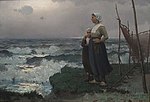
After the Storm, 1884, Private collection
Influences [edit]
Benson was "deeply influenced" past Johannes Vermeer and Diego Velázquez, masters from the seventeenth-century.[xi] Vermeer painted few works during his lifetime, about 35-36 [universally accepted] paintings, merely near each of them has go a masterpiece. The Dutch artist from Delft was astute in his delineation of light and "poetic quality" of his subjects.[12] [13]
- Influences
-
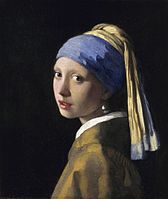
Johannes Vermeer, Girl with a Pearl Earring, ca. 1660–1670, Royal Movie Gallery Mauritshuis, The Hague
-
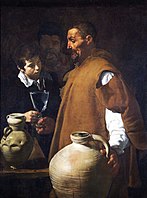
Diego Velázquez, The Waterseller of Seville, 1623, Apsley House, London
Impressionism, peculiarly the work of Claude Monet, played a office in the development of Benson'south own American Impressionistic style. He capitalized on Monet'southward color palette and castor strokes and keenly depicted "reflected low-cal", yet maintained some detail in the limerick. Per Chambers, Benson represented American people with an "ideal of grace, of dignity, of elegance."[14]
- Influences from Impressionism
-

Claude Monet, Two Girls in a Boat
-

Claude Monet, Pont d'Argenteuil
Benson's watercolors reminded some critics of Winslow Homer's works.[five] : 144
- Influences from Winslow Homer
-

Winslow Homer, After the Tornado, watercolor, 1899, Art Institute of Chicago
-

Winslow Homer, The Fog Alert, watercolor, 1885, Museum of Fine Arts, Boston
-

Winslow Homer, oil, Artists Sketching in the White Mountains, 1868, Portland Museum of Fine art
Works of his friends:
- Influences from the works of his friends
-
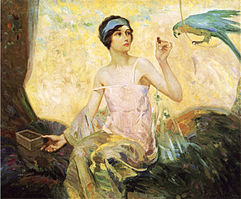
Robert Reid,Tempting Sweets
-

Robert Reid,Her First Born, 1888, Brooklyn Museum
-
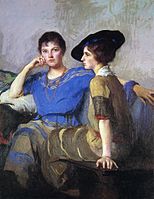
Edmund Tarbell, The Sisters, 1921, Gibbes Museum of Art, Charleston, South Carolina
-
Edmund Tarbell, Arrangement in Pinkish and Gray (Afternoon Tea), ca. 1894, Worcester Art Museum
-

Abbott Thayer, Landscape at Fontainbleau Forest, 1876
-

Abbott Thayer, Dublin Pond, 1894
-

Abbott Thayer, Winged Effigy, 1889, Fine art Institute of Chicago
-

Willard Metcalf, My Wife and Daughter, ca. 1917
Benson was not one to experiment with emerging fine art forms, similar Cubism, Expressionism and Fauvism. As American Impressionism extended to Post-Impressionism about 1913, Benson stayed with traditional genres and his American Impressionist way. As a event, "The pretty, genteel life that Benson had depicted was criticized. Benson's reaction was to turn to nature, and birds replaced the women and children equally his objects of interest." said Dean Lahikainen, curator of the Peabody Essex Museum.[11]
Marriage and children [edit]
In the summertime of 1884 Benson painted at Concarneau, along with Willard Metcalf and Edward Simmons.[15] While there, Benson became engaged to the daughter of friends from Salem, Massachusetts, Ellen Perry Peirson. They married in 1888 when Benson had established himself in his career[eight] and raised 4 children: Eleanor (born 1890), George (born 1891), Elisabeth (born 1892) and Sylvia (born 1898).[five] : 263
-

In Summer, 1887, Private collection. Portrait of Ellen Perry Peirson.
-

Instructor [edit]
Benson became a Portland, Maine Schoolhouse of Art instructor in 1886.[5] : 263 [eight] The jump of 1889 he began teaching antique drawing at the School of the Museum of Fine Arts, Boston and in 1890 became head of the Painting department.[v] : 263 [10] The school's reputation grew and its enrollment tripled under the leadership of Philip Hale, Benson and Edmund C. Tarbell. Students were assessed on the basis of their skill and placed at the appropriate level (from depression to high): Hale had a class for beginners, Benson concentrated on how to depict figures while Tarbell covered all the same lifes.[5] : 24 Benson, a favored instructor called "Cher Maitre" ("Dear Master") by his students,[x] [sixteen] taught until 1913.[fifteen] Amidst his pupils were the portraitist Marie Danforth Page[17] and the miniaturist Bertha Coolidge.[eighteen]
Works [edit]

Moonlight on the Waters oil 1899
William H. Gerdts, art historian, wrote of Benson's work in his introduction to Organized religion Andrews Bedford'southward biography of the painter: "Frank Benson painted some of the well-nigh beautiful pictures ever executed by an American artist. They are images alive with reflections of youth and optimism, projecting a way of life at once innocent and idealized and yet resonant with a sense of sure, selective realities of contemporary times."[11] His work was also function of the art competitions at the 1932 Summertime Olympics and the 1936 Summertime Olympics.[xix]
Realism [edit]
Benson opened his first studio in Salem in 1886 with his friend, Phillip Niggling, and began painting portraits,[5] : 263 [8] an occupation in which Benson took seriously. He once said: "The more a painter knows about his subject, the more he studies and understands it, the more the true nature of it is perceived by whoever looks at it, even though information technology is extremely subtle and not easy to meet or understand. A painter must search deeply into the aspects of a field of study, must know and empathize it thoroughly earlier he tin represent it well."[ten]
Benson took a Boston studio in 1888[five] : 263 with Edmund C. Tarbell.[14] He gained favorable attending in his first showing at the Society of American Artists in New York, with a piece that suggested the influence of academic Realism.[15]
At the proposition of his friend, Joseph Lindon Smith, Benson spent several summers in Dublin from 1889 to 1893,[5] : 26 where he painted with and was influenced by Abbott Thayer. By the early 1890s he began using his family every bit subjects. Benson afterwards recalled information technology was then that he realized design was the well-nigh of import component of painting. Consequently, works of the period evidence a greater involvement in and control of blueprint, silhouette, and abstract design.[fifteen]
Impressionism [edit]
It was only after joining the "Ten American Painters" in 1898 that Benson shifted from the decorative painting of murals (for the Library of Congress) and allegories, to a genuine interest in plein-air Impressionism.[15]
Standing a pattern that the Bensons would follow for years, the family left Boston during the summers. The family unit spent summers in New Castle, New Hampshire from 1893 to 1900,[5] : 263 where Benson made some of his showtime Impressionist paintings, such as Children in the Woods and The Sisters. [10] The popularity of The Sisters, a painting of daughters Elizabeth and Sylvia, won medals in expositions throughout the United States and in Paris, was a prelude to the successes of the adjacent 20 years, when Benson became famous for a series of paintings of his family.[10] [xv] After New Castle, the Bensons spent their summers on Northward Haven Island in Penobscot Bay in Maine at Wooster Farm.[5] : 263 Benson made Impressionist works of his family in earnest at Wooster Farm en plein air.[xx] The summer habitation afforded a great view of the bay and surrounding surface area. Almost the firm was an old orchard, large fields provided plenty of space for the children to play and for a garden, and the property stood beside a wooded area.[v] : 72
Like the French Impressionists, Benson focused on capturing light. To his girl Eleanor he said, "I follow the lite, where it comes from, where it goes."[10] A critic said of Benson'southward piece of work: "It is impossible to believe that mere paint, notwithstanding clearly laid on, can glow and shimmer and sparkle as does that golden light on his canvas."[xi]
Through his role every bit a teacher, work every bit an artist and affiliation with professional organizations for artists, Benson was a leader in American Impressionism.[14] In 1898 Benson and ix other artists including William Merritt Hunt, Thomas Dewing, Childe Hassam, and J. Alden Weir formed "Ten American Painters". They conducted annual exhibitions of their works in New York City and often showed in other cities, such equally Boston, and became known as the American Impressionists.[10] The Traditional Fine Arts Organization claimed he was "one of the concluding great American Impressionists."[11]
-

Eleanor Holding a Shell, 1902, Private collection
-

Wildlife [edit]

Before Benson began his Impressionist paintings of his family unit, he fabricated many seascape and mural paintings.[10] He used several mediums or techniques to capture his love of wildlife, including launder, watercolor, oil, lithography and etching.[21] Regarding his artistic mastery, Peabody Essex Museum curator Dean Lahikainen commented: "Benson was a unique artist, in that he had mastered so many different mediums and subjects. And from his early works right until the very cease, calorie-free is what he was interested in."[11]
Reminiscent of Benson'due south original goal equally an artist to become an ornithological illustrator,[five] : 8 birds were the subjects of most of his washes, etchings, and watercolors.[six]
Wash paintings
- At the Cape Cod hunting cabin that he purchased with his brothers-in-law, Benson began working with black-and-white wash in the 1890s. The works were a commercial success, and then much so that Benson was not able to keep upwards with the demand.[21]
Etching
- In 1914, Benson began etching as an interesting pastime, one that along with his eye for aesthetics, required him to master the complex technique for the desired outcome.[v] : 112 In 1915 he first exhibited etchings of wild fowl, to pop acclaim.[five] : 116–117 Benson turned increasingly to the depiction of landscapes featuring wild fauna, an outgrowth of his interest in hunting and fishing. He went on to produce a steady and profitable output of etchings. One time nigh recognized for his Impressionist paintings, he became equally popular with his etchings. Arthur Philpott, a critic for the Boston Earth, claimed Benson was the "all-time known and about pop etcher in the earth."[5] : 117–118 To one of his daughters he said, "The whole process from the blank plate to the finished print is full of fascinating possibilities and possible failures."[5] : 112 Benson, 1 of the best printmakers of the 20th century, is credited with making wildlife prints a distinct genre.[22] Benson was a fellow member of the Society of American Graphic Artists, known as The Society of American Etchers from 1915 - 1947, based in New York City and participated in many exhibitions.
Watercolors

- Benson'due south watercolor paintings began on a Canadian fishing trip in 1921.[21] and were often the products of bird-hunting sojourns in Cape Cod and salmon fishing expeditions in Canada. were favorably compared to similar works by .[5] : 134, 144 A critic wrote of his watercolors, "The dearest of the almost archaic wilderness which appears in many of (Winslow) Homer'due south landscapes and the swift, sure touch with which he suggests rather than describes--these also narrate Benson'south work. The solitude of the northern woods is very much like Homer'south." Benson made more than 500 watercolors in his lifetime.[21]
Oil paintings
- Hunter in a Boat (1915) and Twilight (1930) are a few examples of Benson's oil paintings of wild fauna settings.[21]
Benson was elected in 1919 as the first president of the Essex County Ornithological Society.[five] : 264
At the request of boyfriend creative person and conservationist Jay Norwood "Ding" Darling, Benson designed the 2d Federal Duck Stamp in 1935.[5] : 235
Gallery [edit]
-

Eleanor, 1907
-

Summer, 1909
-

Elizabeth and Ann, c.1909
-

Summer, portrait of countess Rita de Candia, 1909
-

Margaret Gretchen Strong, 1909
-
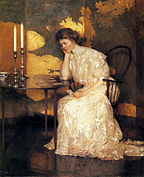
Playing Solitaire oil 1909
-
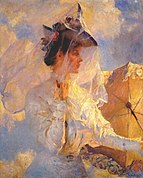
Confronting the Sky, ca. 1912
-

Written report for Young Girl with a Veil, 1912
-

The Gray Room, 1913
-

The Dining Room Table, 1919
-

Great White Herons 1923
Death and posthumous sales [edit]
He is buried in Salem's Harmony Grove Cemetery.[23]
To appointment the highest price brought at auction for an oil painting by Benson is $4.1 meg, realized at Sotheby's in 1995.[24]
On Oct 19, 2006, a watercolor painting by Benson was sold at auction for $165,002. The painting was anonymously donated to an Oregon Goodwill Industries site, virtually probable without the owner knowing of its value. Behest on the shopgoodwill.com website started at $10, and increased afterward the work was authenticated.[25]
Figure in a Room [edit]

Figure in a Room by Frank Weston Benson, 1912, oil on canvas - New Britain Museum of American Art

Benson's Figure in a Room, a 1912 realistic oil painting of a woman standing behind a small table in a room, was involved in a controversy that surfaced long later the death of the artist.[26] The Detroit Club apparently purchased the painting in 1914, following an showroom held there by Benson. At some fourth dimension during the next several decades, the painting was replaced on the club's premises by an excellent imitation or forgery, which was inserted into the painting's original frame. The original Benson was eventually obtained by a collector named Donald Purdy, and subsequently by the New Britain Museum of American Fine art. The fake Benson painting remaining with the Detroit Lodge was finally sold for $38,500 to an attorney and his wife, at an auction held by Christie's in 1986. When the new owners began their own enquiry of the painting many years afterwards, they learned that the New Britain Museum had a strikingly similar painting from Benson in their drove; the couple'south subsequent endeavor to sell the painting concluded when Sotheby's (who also learned of the New Britain painting) pronounced information technology to be a probable fake. A lawsuit was filed against Christie'due south, alleging negligence and/or fraud;[27] but a Delaware Courtroom ruled in favor of the defendants,[28] opining that the auctioneer's fiduciary responsibleness was with the seller rather than with the purchaser. The courtroom also noted that Christie'south six-year warranty of authenticity, clearly communicated, had long since expired. Today, the two "Figure in a Room" paintings involved in this controversy hang next at the New Uk (CT) Museum; visitors are invited to determine for themselves which is existent and which is imitation. Benson scholar, Faith Andrews Bedford, notes that the frame is a hand-carved frame by Wilfred Thulin, one of the members of the famed Boston school of arts and crafts framemakers. She has recently donated to the museum the mandarin glaze worn past the model in the painting.
Exhibitions and shows [edit]
- 1885 - After the Storm at the Royal Academy in London
- 1889 - National Academy of Design in New York, won offset prize for Orpheus
- 1891 - Kickoff private testify of Benson's piece of work, Hunt Gallery, Boston with Edmund C. Tarbell
- 1894 - First known wildfowl exhibition, exhibited Swan Flight
- 1897 - With nine other men, held their own exhibition in New York City
- 1898 - Offset exhibition as the Ten American Painters in New York City
- 1899 - Second exhibition as the X American Painters in New York Metropolis, including Children in the Wood, the offset Impressionist painting exhibited by Benson
- 1900 - The Sisters was presented at the Paris Exposition Universelle and won a argent medal
- 1904 - First known exhibition of a still life past Benson
- 1912 - Kickoff known showing of black and white wash drawings, Ten American Painters testify
- 1913 - Outset one-man show devoted to wash drawings of wildfowl, Copley Society of Art, Boston
- 1915 - Benson's etchings were exhibited for the starting time time, The Guild of Boston Artists
- 1915 - Start one-human evidence devoted to etchings, George Gage Gallery
- 1915 - First one-man show devoted to etchings in New York, Kennedy Galleries
- 1916 - Beginning one-homo show devoted to etchings outside of the United states of america, British Museum
- 1922 - First exhibition of his watercolors in New York, Boston and Cleveland
- 1945 - His last 1-human exhibition of etchings at Arthur Harlow & Sons Gallery, New York
- 1950 - His final exhibition at the Pennsylvania Academy of the Fine Arts[v] : 263–264
Retroactive exhibitions of his piece of work occurred in 1921 at the Gild of Boston Artists in 1917,[5] : 241 Corcoran Gallery of Art, in 1924 at the Carnegie Institute and the Akron Art Museum, in 1936 at Guy E. Mayer Gallery in New York and in 1938 in the Museum of Fine Arts in Boston.[5] : 263–264 Such was its popularity that the exhibition bankrupt the museum'due south attendance records.[5] : 241
Awards and acclamation [edit]

Emily Vanderbilt Binney oil 1894
In the 1890s he began receiving his outset awards, subsequently the plow of the century he won awards for his Impressionist paintings, and his wildlife watercolors and etchings won awards in the 1920s and 1930s and up to historic period 86.[21] In 1914 the Boston Transcript called Benson "America's Virtually Medalled Painter."[six]
Awards that Benson won include:
- 1889 Third Hallgarten Prize, National University in New York for Orpheus [5] : 263–264 [10]
- 1891 Thomas B. Clark Prize, National University[nine]
- 1896 Shaw Fund Prize, Society of American Artists[9]
- 1900 Argent Medal, Paris Exposition Universelle for The Sisters [5] : 263–264
- 1903 Beginning Prize, Carnegie Prize, Pittsburgh [29]
- 1906 Thomas R. Proctor Prize, National University[9]
- Henry Ward Ranger Fund prize for Still Life, at present at the National Museum of American Fine art[21]
- 1922 Frank G Logan prize for All the same Life [30]
- 1924 Frank G Logan prize[30]
He received an honorary Master of Fine Arts degree from Tufts University in 1930 and was selected into the National Institute of Letters and Arts in 1945.[5] : 264
Organizations [edit]
- 1888 - Became a member of the Lodge of American Artists[5] : 263–264
- 1897 - Elected associate, National Academy of Design, New York[v] : 263–264
- 1898 - Founding member of the American Academy of Arts and Letters[v] : 263–264
- 1898 - Resigned from the Guild of American Artists[five] : 263–264
- 1905 - Accomplished full membership condition, National Academy of Design, New York[5] : 263–264
- 1914 - With six others, founded The Social club of Boston Artists[5] : 263–264 Having difficulty getting local artist'southward work exhibited exterior of Boston, Benson helped plant The Guild of Boston Artists[5] : 112 and was the president for thirteen years.[6] Modeled on the historic guilds of Europe, the organization held high professional standards in a supportive environs. In their Newbury gallery, annual shows of works of all members were interspersed with ii-week 1-person shows that highlighted the piece of work of individual artists.[5] : 112
- 1926 - Elected a Young man of the American Academy of Arts and Sciences[31]
- 1937 - Get-go documented showing as a member of the Society of American Graphic Artists
See also [edit]
- List of works by Frank Weston Benson
Notes [edit]
- ^ a b Hook, Bailey Van (2003). "Benson, Frank W(eston)". Grove Art Online. doi:10.1093/gao/9781884446054.commodity.T007956.
- ^ frankwbenson. Biography
- ^ "Frank Weston Benson". The Art Establish of Chicago . Retrieved 2021-12-11 .
- ^ "Frank Weston Benson". USEUM . Retrieved 2021-12-11 .
- ^ a b c d e f m h i j k l m due north o p q r south t u v westward ten y z aa ab ac advertising ae af ag ah ai aj ak al am an ao ap aq ar as at Bedford (2000)
- ^ a b c d McAllister, Salem Tales: Frank Weston Benson.
- ^ About John Benson.
- ^ a b c d Peabody Essex Museum, Interactive Presentation, Benson Timeline.
- ^ a b c d e f Dearinger, p. twoscore.
- ^ a b c d e f g h i j k 50 Bedford, Frank Weston Benson Biography, p. one.
- ^ a b c d e f Traditional Fine Arts Organization, Low-cal Shines on Frank W. Benson: American Impressionist.
- ^ "Johannes Vermeer (1632-1675)". Mauritshuis, The Hague. Archived from the original on 2012-03-14. Retrieved 2011-07-05 .
- ^ Pioch, Nicolas (2002-10-xiv). "Vermeer, Jan". The WebMuseum. Retrieved 2011-07-05 .
- ^ a b c Chambers, Red and Gilt.
- ^ a b c d east f Hiesinger, p. 233.
- ^ "Cher Maitre". Cher Maitre. 2011. Retrieved 2011-07-05 .
- ^ Eleanor Tufts; National Museum of Women in the Arts (U.S.); International Exhibitions Foundation (1987). American women artists, 1830-1930. International Exhibitions Foundation for the National Museum of Women in the Arts. ISBN978-0-940979-01-7.
- ^ Metropolitan Museum of Art (New York, Due north.Y.); Carrie Rebora Barratt; Lori Zabar (one January 2010). American Portrait Miniatures in the Metropolitan Museum of Art. Metropolitan Museum of Art. ISBN978-ane-58839-357-9.
- ^ "Frank Weston Benson". Olympedia . Retrieved 2 August 2020.
- ^ Bedford, Frank Weston Benson Biography, p. 1-2.
- ^ a b c d e f thousand Bedford Biography, p. 2.
- ^ Frank Due west. Benson, AskArt.
- ^ Spencer, Thomas East. (2001). Where they're buried: a directory containing more 20 one thousand names. Baltimore: Clearfield Company, printed by Genealogical Publishing. p. 326. ISBN9780806348230.
- ^ Forbes.com, Beguiling Gulls.
- ^ Painting Sold at Goodwill for $165,002
- ^ "Museum Ethics: Fakes on Brandish". New Uk Museum of American Art (web log). 2010.
- ^ Pileggi, Francis G.Ten. (2006). "Chancery Court Bars Merits for False Artwork".
- ^ "Johannes R. Krahmer and Betty P. Krahmer v. Christie's Incorporated". Delaware Chancery Court. 2006.
- ^ Howland, Austin E. (1903). "Eighth Almanac Exhibition of Paintings at Pittsburgh". Castor and Pencil. 13 (2): 137–153. doi:10.2307/25503679. JSTOR 25503679.
- ^ a b "FRANK WESTON BENSON (1862-1951)PAPERS, 1864-1976". Peabody Essex Museum. Retrieved 3 February 2015.
- ^ "Book of Members, 1780–2010: Chapter B" (PDF). American Academy of Arts and Sciences. p. 17. Retrieved June xv, 2011.
References [edit]
- "About John Benson", John Prentiss Benson — American Marine Artist Book site, Retrieved June 12, 2011.
- Bedford, Religion Andrews (1999). "Frank W. Benson: American Impressionist, published past Rizzoli, 1994". Faith Andrews Bedford. Archived from the original on 2011-07-04. Retrieved 2011-07-03 .
- Bedford, Faith Andrews (2000). The Sporting Art of Frank Due west. Benson. Jaffrey, NH: David R. Godine. ISBN1-56792-111-6.
- Chambers, B. "Frank W. Benson, Red and Gold". Butler Institute of American Art. Archived from the original on 2011-09-27. Retrieved 2011-06-08 .
- Dearinger, David Bernard (2004). Paintings and Sculpture in the Collection of the National Academy of Design. Manchester, VT: Hudson Hills Press. ISBN1-55595-029-9.
- "Frank W. Benson, American Impressionist, Interactive presentation, Timeline". Peabody Essex Museum. Archived from the original on 2011-07-25. Retrieved 2011-06-08 .
- "Frank Weston Benson (1862 - 1951)". AskART. 2000–2011. Retrieved 2011-06-16 .
- Hiesinger, Ulrich W., Impressionism in America: The 10 American Painters, Prestel-Verlag, 1991.
- "Light Shines on Frank Due west. Benson: American Impressionist". Traditional Fine Arts System, Inc. 2011. Retrieved 2011-07-05 .
- McAllister, Jim (2011). "Salem Tales: Frank Weston Benson". SalemWeb. Retrieved 2011-07-05 .
Farther reading [edit]
- Chisholm, Hugh, ed. (1911). . Encyclopædia Britannica. Vol. 3 (11th ed.). Cambridge Academy Printing.
External links [edit]
- Frank West. Benson information site
- Frank Weston Benson exhibition catalog
- Artwork by Frank Weston Benson
Source: https://en.wikipedia.org/wiki/Frank_Weston_Benson
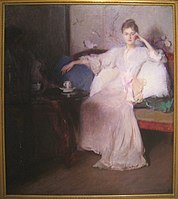

0 Response to "Is Frank W Benson Art Work Frfamedthe Hilltop Worth Anuythiong"
Post a Comment